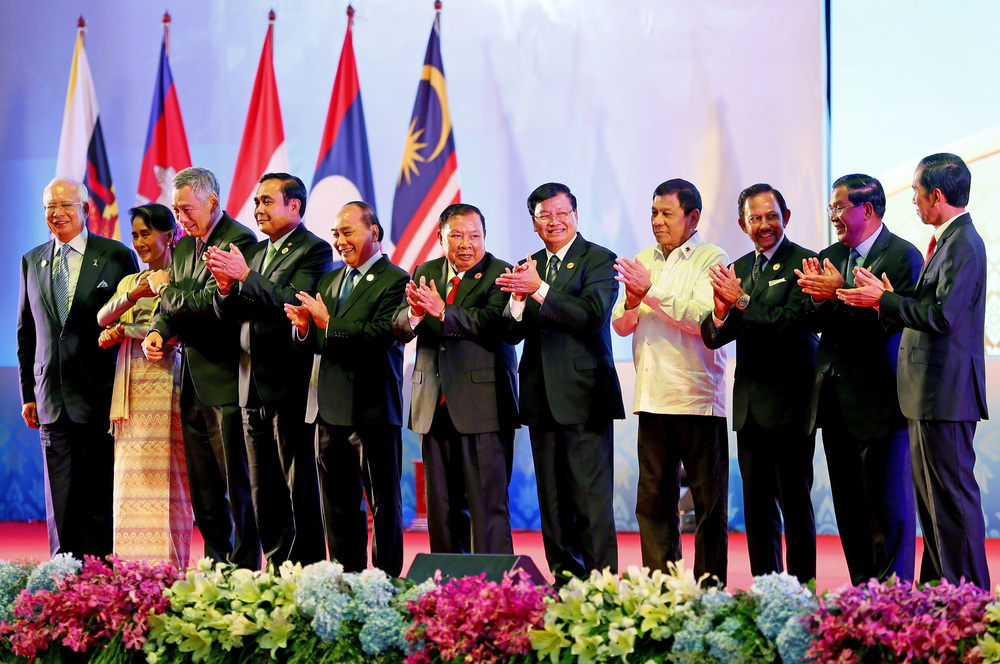Commentary: ASEAN members must have a keen sense of balance

Leaders of the Association of Southeast Asian Nations (ASEAN) pose for a group photo following 28th ASEAN summit plenary meeting at National Convention Center in Vientiane, Laos, Tuesday, Sept. 6, 2016. Leaders from left, Myanmar's State Counsellor and Foreign Minister Aung San Suu Kyi, Singapore's Prime Minister Lee Hsien Loong, Thai Prime Minister Prayuth Chan-ocha, Vietnam's President Tran Dai Quang, Laos Prime Minister Thongloun Sisoulith, Philippine's President Rodrigo Duterte, Brunei Foreign Minister and Prime Minister Sultan Hassanal Bolkiah, Cambodian Prime Minister Hun Sen, Indonesia's President Joko Widodo and Malaysia's Prime Minister Najib Razak. AP/Gemunu Amarasinghe, File photo
ASEAN’s infrastructure gap is often identified as a major hindrance to doing business in the region. Infrastructure linkages among member states are still underdeveloped, hindering these countries from maximizing the benefits of integration. As cities are urbanizing rapidly, the need to bridge the infrastructure gap is becoming more urgent.
In the last few months, the Duterte administration has been building up its infrastructure campaign, as the country catches up on years of underinvestment in the sector. By 2022, the government intends to spend 7.4 percent of gross domestic product (GDP) on its infrastructure program. Thailand is also ramping up its infrastructure drive, allocating some US$ 40 billion for infrastructure investments. In 2016, several projects were bid out and another 36 projects have been lined up this year. Meanwhile, ASEAN countries with more limited spending rooms have turned to other modes of financing, including public-private partnerships (PPP) and loans from multilateral institutions.
A special study published by Stratbase ADR Institute, entitled “ASEAN’s Golden Opportunity: The Future of Southeast Asia,” co-written with my colleague, Angelica Mangahas, discusses Japan and China’s rivalry in the Southeast Asian region, not only in military terms, but in infrastructure provision as well. In recent years, firms from both countries, backed by their respective governments, have secured high-profile deals across the region. In 2015, for instance, a Chinese firm won a US$ 5 billion contract to build a high-speed railway in Indonesia. Meanwhile, in Thailand, a Japanese firm is set to construct a high-speed rail link by 2019.
Unlike its predecessor’s preference for PPP, the Duterte government seems more inclined to finance its big-ticket infrastructure projects through overseas development assistance (ODA). Since the president’s state visit in China and Japan last year, several Philippine delegations have visited both countries to discuss infrastructure deals. This week, National Economic and Development Authority Secretary Ernesto Pernia announced that nine projects amounting to P738 billion are up for approval. Of these, eight will reportedly be funded by ODA loans. With the country’s infrastructure drive and a foreign policy shift, the rivalry between these two countries has only magnified.
While Japan has conventionally led infrastructure provision in the region, China is rapidly gaining foothold in ASEAN. With a crowded domestic market, Chinese firms are encouraged to pursue investments abroad. China is already the leading investor in Cambodia, Laos and Myanmar; its investments in Vietnam, Thailand, Malaysia, Philippines and Indonesia are also growing.
Last month, several ASEAN leaders gathered in Beijing for the Belt and Road Forum, where several cooperation deals in infrastructure, trade and investment, among others, were signed. Four years ago, the Chinese government revived its Belt and Road Initiative and created the Silk Road Fund to support this program. The plan seeks to link over 60 countries in Asia and Europe through land-based and maritime infrastructure. China’s establishment of the Asian Infrastructure and Investment Bank (AIIB) in 2016 strengthened its role as a key financer in the region, despite numerous concerns that the bank’s environmental and social frameworks does not meet international standards.
In response to China’s increasing clout, Japan has simplified the procedures for its ODA loans and has trumpeted its more superior record in terms of quality, technology, and social and environmental protection. Since the AIIB was conceptualized, the Japan-backed Asian Development Bank has also increased its lending by 19 percent.
The heightened competition between China and Japan presents a good opportunity for ASEAN countries to narrow their infrastructure deficits. However, ASEAN members must exercise appropriate caution as unrestrained spending could result in unsustainable debt burdens. Moreover, ASEAN members must learn to balance their political and economic relationships with both countries; too much dependence on either country will limit us from asserting our own interests. ASEAN’s infrastructure gap is often identified as a major hindrance to doing business in the region. Infrastructure linkages among member states are still underdeveloped, hindering these countries from maximizing the benefits of integration. As cities are urbanizing rapidly, the need to bridge the infrastructure gap is becoming more urgent.
In the last few months, the Duterte administration has been building up its infrastructure campaign, as the country catches up on years of underinvestment in the sector. By 2022, the government intends to spend 7.4 percent of gross domestic product (GDP) on its infrastructure program. Thailand is also ramping up its infrastructure drive, allocating some US$ 40 billion for infrastructure investments. In 2016, several projects were bid out and another 36 projects have been lined up this year. Meanwhile, ASEAN countries with more limited spending rooms have turned to other modes of financing, including public-private partnerships (PPP) and loans from multilateral institutions.
A special study published by Stratbase ADR Institute, entitled “ASEAN’s Golden Opportunity: The Future of Southeast Asia,” co-written with my colleague, Angelica Mangahas, discusses Japan and China’s rivalry in the Southeast Asian region, not only in military terms, but in infrastructure provision as well. In recent years, firms from both countries, backed by their respective governments, have secured high-profile deals across the region. In 2015, for instance, a Chinese firm won a US$ 5 billion contract to build a high-speed railway in Indonesia. Meanwhile, in Thailand, a Japanese firm is set to construct a high-speed rail link by 2019.
Unlike its predecessor’s preference for PPP, the Duterte government seems more inclined to finance its big-ticket infrastructure projects through overseas development assistance (ODA). Since the president’s state visit in China and Japan last year, several Philippine delegations have visited both countries to discuss infrastructure deals. This week, National Economic and Development Authority Secretary Ernesto Pernia announced that nine projects amounting to P738 billion are up for approval. Of these, eight will reportedly be funded by ODA loans. With the country’s infrastructure drive and a foreign policy shift, the rivalry between these two countries has only magnified.
While Japan has conventionally led infrastructure provision in the region, China is rapidly gaining foothold in ASEAN. With a crowded domestic market, Chinese firms are encouraged to pursue investments abroad. China is already the leading investor in Cambodia, Laos and Myanmar; its investments in Vietnam, Thailand, Malaysia, Philippines and Indonesia are also growing.
Last month, several ASEAN leaders gathered in Beijing for the Belt and Road Forum, where several cooperation deals in infrastructure, trade and investment, among others, were signed. Four years ago, the Chinese government revived its Belt and Road Initiative and created the Silk Road Fund to support this program. The plan seeks to link over 60 countries in Asia and Europe through land-based and maritime infrastructure. China’s establishment of the Asian Infrastructure and Investment Bank (AIIB) in 2016 strengthened its role as a key financer in the region, despite numerous concerns that the bank’s environmental and social frameworks does not meet international standards.
In response to China’s increasing clout, Japan has simplified the procedures for its ODA loans and has trumpeted its more superior record in terms of quality, technology, and social and environmental protection. Since the AIIB was conceptualized, the Japan-backed Asian Development Bank has also increased its lending by 19 percent.
The heightened competition between China and Japan presents a good opportunity for ASEAN countries to narrow their infrastructure deficits. However, ASEAN members must exercise appropriate caution as unrestrained spending could result in unsustainable debt burdens. Moreover, ASEAN members must learn to balance their political and economic relationships with both countries; too much dependence on either country will limit us from asserting our own interests.
Weslene Uy is a senior research associate at the Stratbase ADR Institute.
- Latest




























